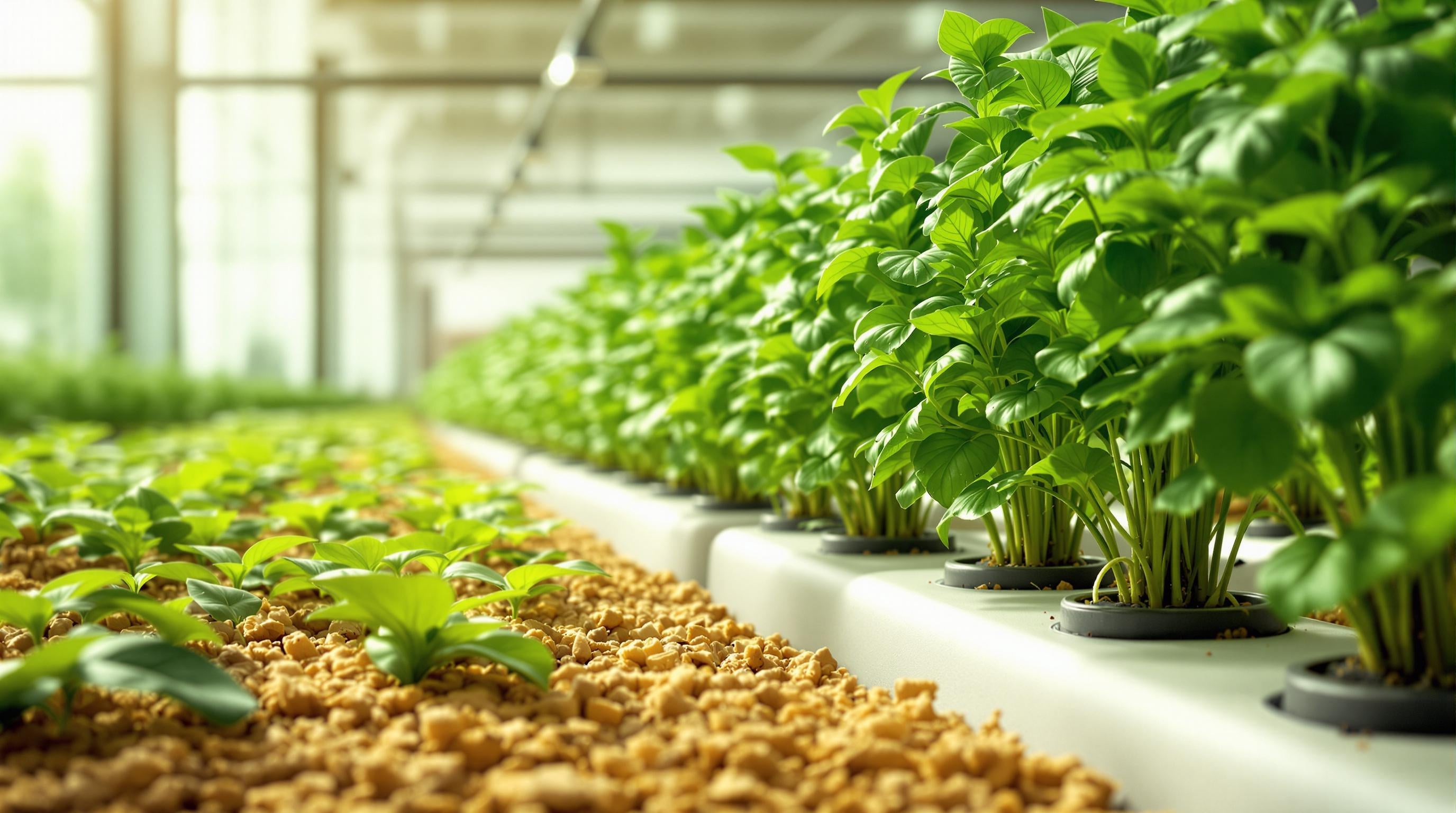Coconut coir is a top choice for hydroponics because it balances water retention, drainage, and airflow, creating ideal conditions for plant roots. Sourced from coconut husks, this sustainable medium is easy to prepare, maintain, and reuse. Here’s why it works so well:
- Water Management: Holds moisture while preventing waterlogging and root rot.
- pH Stability: Maintains a stable pH, reducing the need for adjustments.
- Eco-Friendly: Made from coconut byproducts, repurposing waste materials.
How to Use Coconut Coir
- Prepare the Coir: Soak a compressed block in warm water to expand it.
- Mix Blends: Combine with perlite or vermiculite for better aeration or moisture retention.
- Choose a System: Use pure coir in drip irrigation or mix with other media for added benefits.
Coconut coir supports crops like leafy greens, tomatoes, and even root vegetables. For the best results, manage nutrients carefully, flush salts regularly, and maintain the coir between cycles.
Coco Coir Grow Media Hydroponics 101
Why Use Coconut Coir in Hydroponics
Coconut coir is a popular choice for hydroponics because it creates ideal growing conditions while promoting eco-conscious gardening. Let’s break down how it helps with water management, pH balance, and sustainability.
Water Management and Air Circulation
Thanks to its fibrous texture, coconut coir holds onto moisture while still allowing airflow. This balance helps prevent waterlogging and root rot, keeping plants healthy and thriving.
Stable pH Levels
Coconut coir naturally maintains a stable pH, supporting consistent nutrient absorption and strong root growth. This reduces the need for frequent pH adjustments, making it easier to manage.
Sustainable Growing Medium
Made from coconut byproducts, coir is a sustainable option that repurposes waste materials. This makes it a smart choice for gardeners looking to minimise their environmental footprint.
These benefits pave the way for effective preparation and application techniques, which we’ll cover later.
Preparing Coconut Coir
Here’s how to prepare coconut coir for hydroponics.
Soaking and Expanding
Start by placing a compressed coir block in a container that’s about three times its size. Gradually add warm water (around 25°C) until the block is fully submerged. A typical 5kg compressed block will expand to roughly 60–70 litres of growing medium.
Follow these steps for proper hydration:
- Initial soaking: Let the block soak for 30–45 minutes.
- Break it up: Gently loosen and break apart any clumps.
- Final expansion: Allow the coir to sit for another 4–6 hours to fully expand.
Once expanded, you can adjust its properties by creating custom coir blends.
Creating Coir Blends
While pure coir works fine, mixing it with other materials can improve your growing environment.
| Blend Type | Coir Ratio | Additional Medium | Benefits |
|---|---|---|---|
| Standard Mix | 70% | 30% perlite | Better drainage and aeration |
| Heavy Feeder Mix | 60% | 40% vermiculite | Greater moisture retention |
| Root Crop Mix | 50% | 50% perlite | Optimal root zone aeration |
For best results, mix the components while the coir is still damp. This ensures an even blend and consistent growing conditions.
Looking for high-quality coconut coir and hydroponic supplies? Check out Green Genius (https://greengenius.com.au).
sbb-itb-28a8941
Using Coconut Coir in Different Systems
Coconut coir, when prepared correctly, can be used in a variety of hydroponic systems, each requiring its own setup approach.
Pure Coir Systems
Coconut coir can serve as the only growing medium in systems like drip irrigation and nutrient film technique (NFT). For drip systems, fill grow bags with coir, ensuring they have adequate drainage, and position drippers to distribute water evenly. In NFT setups, use net pots filled with coir, placing them in channels. Choose pot sizes based on the specific needs of your plants.
Mixed Media Systems
Blending coconut coir with materials like clay pebbles or perlite can improve drainage, aeration, and plant stability. Adjust the mix to strike the right balance of moisture retention and structural support, depending on the type of plants you're growing.
Planting Guide
Before planting, evenly moisten the coir. Create holes large enough to fit the plant roots without overcrowding them, and transplant seedlings at the same depth they were growing before. Keep an eye on moisture levels - containers should feel heavy but not overly wet. For larger systems, you might want to use moisture sensors to automate watering.
These tailored practices help ensure proper nutrient delivery and easy maintenance of your coir-based system. For high-quality coir products and hydroponic supplies, check out Green Genius (https://greengenius.com.au).
Tips for Success with Coconut Coir
If you're using coconut coir in your hydroponic system, focus on managing nutrients, maintaining the coir, and selecting the right crops for the best results.
Nutrient Management
Start with a balanced hydroponic nutrient solution and adjust it as your plants grow. Regularly check electrical conductivity (EC) and pH levels to ensure nutrients are delivered effectively. To prevent salt buildup, flush the coir periodically with pH-adjusted water. This helps keep the roots healthy and thriving.
Coir Maintenance
Proper care of the coir ensures it remains effective for plant growth. After each growing cycle, remove leftover roots and loosen any compacted areas to improve airflow. Clean or sterilise the coir according to local recommendations before reusing it. For larger setups, moisture meters can help you maintain the right dampness without overwatering. Green Genius offers meters tailored for coir-based systems, making this task easier.
Plants That Grow Well in Coir
Coconut coir works well for a variety of crops. Leafy greens like lettuce, spinach, and herbs benefit from its ability to balance moisture and aeration. Fruiting plants such as tomatoes, capsicums, and strawberries develop strong roots in this medium. Even root vegetables like radishes and baby carrots can thrive in coir beds, as long as the containers are deep enough and moisture levels are kept steady to avoid overwatering.
Conclusion
Coconut coir provides an excellent balance of water retention and aeration, making it a great choice for hydroponics. Its structure and properties work especially well in controlled growing setups.
When properly maintained, coconut coir helps conserve water and allows for precise nutrient management. As Green Genius puts it: > "At Green Genius, our mission is to promote sustainable gardening practices to instil a flow-on effect in the wider environment."
With its efficiency, natural origins, and reusability, coconut coir plays a key role in hydroponic farming. Its ability to deliver consistent growing conditions while supporting eco-friendly practices highlights its importance in modern agriculture.

